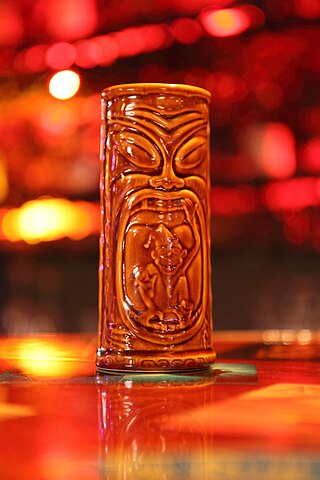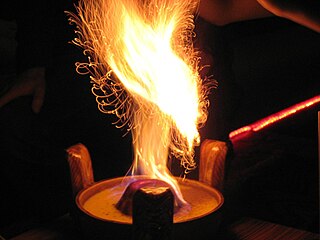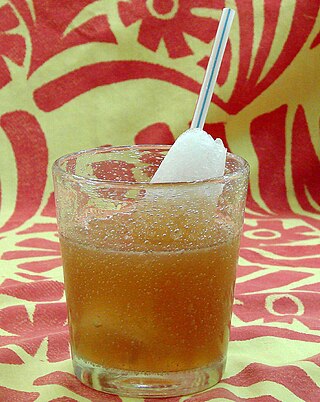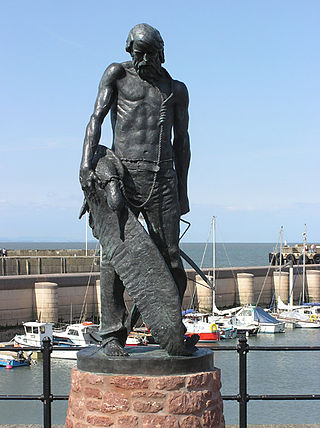
Tiki culture is an American-originated art, music, and entertainment movement inspired by Polynesian, Melanesian, and Micronesian cultures, and by Oceanian art. Influential cultures to Tiki culture include Australasia, Melanesia, Micronesia, Polynesia, the Caribbean Islands, and Hawaii. The name comes from Tiki, the Māori name for the first human, often represented in the form of hei-tiki, a pendant and important taonga. The hei-tiki was often appropriated by Europeans as a commercialised good luck charm, hence the name of Tiki culture. Despite spanning over 10,000 miles and including many different unrelated cultures, religions, and languages, Tiki aesthetic is considered by some to be amalgamated into one "fantasia of trans-Pacific cultures" and "colonial nostalgia". Because of this, and the simplistic view of the Pacific taken by the aesthetic, Tiki culture has often proved controversial.

The Mai Tai is a cocktail made of rum, Curaçao liqueur, orgeat syrup, and lime juice. It is one of the characteristic cocktails in Tiki culture.

The Zombie is a Tiki cocktail made of fruit juices, liqueurs, and various rums. It first appeared in late 1934, invented by Donn Beach at his Hollywood Don the Beachcomber restaurant. It was popularized on the East coast soon afterwards at the 1939 New York World's Fair.

Falernum is either a syrup liqueur or a nonalcoholic syrup from the Caribbean. It is best known for its use in tropical drinks. It contains flavors of ginger, lime, and almond, and frequently cloves or allspice. It may be thought of as a spicier version of orgeat syrup.
Fassionola is a typically fruit-flavored, red-colored syrup that was frequently used in tropical drinks during the 1930s but is now a relatively unusual ingredient. It also comes in green and gold varieties that are sometimes made to taste differently. It is used as a fruit punch concentrate, and some claim that a red-colored fruit syrup called fassionola was an ingredient in the original Hurricane cocktail. Although a frequent attribution, solid evidence of fassionola's use in the Hurricane from before 1956 is lacking, and it is not known what the precise ingredients were in the earliest version of fassionola.

A tiki mug is a large ceramic cocktail drinking vessel that originated in tiki bars and tropical-themed restaurants. The term "tiki mug" is a blanket term for the sculptural drinkware even though they vary in size and most do not contain handles. They typically depict Polynesian, mock-Polynesian, tropical, nautical, or retro themes, and as the term is used generically do not always emulate a tiki. When used to serve drinks they are frequently garnished with fruit or decorative drink umbrellas and swizzle sticks.

A tiki bar is a themed drinking establishment that serves elaborate cocktails, especially rum-based mixed drinks such as the Mai Tai and Zombie cocktails. Tiki bars are aesthetically defined by their tiki culture décor which is based upon a romanticized conception of tropical cultures, most commonly Polynesian. Some bars also incorporate general nautical themes or retro elements from the early atomic age.
A Scorpion Bowl is a communally shared alcoholic tiki drink served in a large ceramic bowl traditionally decorated with wahine or hula-girl island scenes and meant to be drunk through long straws. Bowl shapes and decorations can vary considerably. Starting off as a single-serve drink known as the Scorpion cocktail, its immense popularity as a bowl drink in tiki culture is attributed to Trader Vic.

Flaming volcano is a large tropical group cocktail typically made with rum, brandy, pineapple juice, orange juice, and orgeat syrup. Many variations exist, and the cocktail in the 21st century is more about the presentation than an adherence to a set list of ingredients. It is usually a multi-user drink, served to a group in a special vessel known as a volcano bowl, which is a decorative ceramic bowl designed with a rising central hub feature resembling a volcanic cone. The cone includes a "crater" reservoir which can be partially filled with rum or another flammable liquor. The crater liquor is carefully ignited when serving, creating a mild volcanic ambiance with its central blue flame.

The Navy Grog was a popular rum-based drink served for many years at the Polynesian-themed Don the Beachcomber restaurants; it is still served in many tiki restaurants and bars. First created by Donn Beach, who almost single-handedly originated the tiki cultural fad of the 1940s and 1950s, it was one of dozens of rum concoctions that he, and later Trader Vic and numerous other imitators, sold in exotic tropical settings. Not quite as potent as the Beachcomber's more famous Zombie, it was, nevertheless, shown on the menu as being limited to two, or sometimes three, to a customer. Reportedly, Phil Spector consumed at least two Trader Vic’s Navy Grogs at the Beverly Hilton restaurant, without eating any food, the night he later killed actress Lana Clarkson.

The doctor cocktail is a pre-prohibition era cocktail that traces in drink guides to as far back as 1917, when it appeared in Hugo R. Ensslin's Recipes for Mixed Drinks. As originally described the cocktail called simply for Swedish Punsch mixed with lime juice.

The suffering bastard is the name for two different mixed drinks, one being more of a standard cocktail associated with World War II and the other being more of an exotic drink associated with Tiki bars. As is the case with many cocktails, there are multiple recipe variations and historical origins have been argued and changed over time. Two of the earliest recipe versions have very different ingredients. One from bartender Joe Scialom (1942) calls for brandy and gin, while another from Tiki pioneer Victor J. Bergeron primarily uses rum along with "secret ingredients" and is known for being garnished with a cucumber.
The Q.B. Cooler is a vintage tiki cocktail invented by Donn Beach that calls for a mixture of several rums, two syrups, fruit juices, and honey, mixed with club soda and dashes of Pernod, bitters, and grenadine. Another version purported to be from 1937 is slightly different and calls for varying rum proportions and ginger syrup in place of the fassionola and Pernod.
The Sumatra Kula is a vintage tiki cocktail invented by Donn Beach that calls for light rum, equal parts orange, lime and white grapefruit juices, and is sweetened with a diluted honey mix.
The test pilot cocktail is a vintage tiki drink invented by Donn Beach. Beach was known for changing his recipes over time, and multiple versions of the test pilot attributed to both him and others make the cocktail one of his more frequently imitated and varied tiki drinks. Test pilot recipes call for multiple rums and typically include the use of falernum syrup and lime juice. The more popular also include Pernod (pastis/absinthe) and bitters.
Mr. Bali Hai is a tiki drink served in a special mug at the Bali Hai restaurant on Shelter Island in San Diego, California. The drink has had different recipes over the years, but a prominent version from the 1970s calls for 1 1/2 oz of dark Jamaican rum, 1 oz light Puerto Rican rum, 3/4 oz coffee flavored brandy, 1 1/2 oz unsweetened pineapple juice, 1 oz lemon juice, and 1/2 oz of sugar syrup. The mug has the same name as the drink, Mr. Bali Hai, and comes in the shape of a headhunter's head with a removable lid.
The Fog Cutter is a vintage tiki cocktail frequently attributed to being invented by Victor Bergeron that calls for a mixture of several liquors, the juice of lemon and oranges, orgeat syrup, and cream sherry. It is high in alcoholic content and has been called the "Long Island Iced Tea of exotic drinks." It has historically been served in special Fog Cutter ceramic mugs.

The Ancient Mariner is a tiki drink created by Jeff "Beachbum" Berry and Annene Kaye. It first appeared in their 1998 drink guide Beachbum Berry's Grog Log and is named after Coleridge's 1798 The Rime of the Ancient Mariner because in Berry's words "by the time we finished with it, that's how old we felt."
The PB2Y, or PB2Y Gremlin, is a tiki drink created by Victor Bergeron as part of a series of "gremlin" drinks for his Trader Vic's restaurants during World War II.











